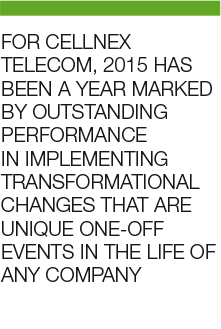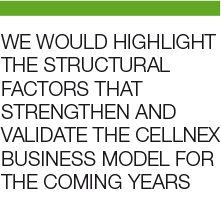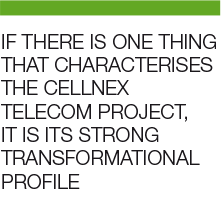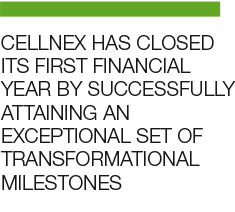connect
people
Annual
Report
2015



Dear Shareholders,
We are pleased to introduce Cellnex Telecom’s inaugural annual report. Stressing that this is the Company’s “first” annual report, already says a lot about what financial year 2015 has meant in terms of recasting and transforming a business project that, until May, operated as the “Terrestrial Telecommunications” division of the Abertis Group.
For Cellnex Telecom, 2015 has been a year marked by outstanding performance in implementing transformational changes that are unique one-off events in the life of any company:
 With this excellent set of factors in place, already extraordinary in itself, the foundations have been laid for a project that has the critical mass, talent and equipment, international presence, visibility and exposure to financial markets to equip it to handle growth projects, with full autonomy, to consolidate its position as Europe’s leading telecommunications infrastructure operator.
With this excellent set of factors in place, already extraordinary in itself, the foundations have been laid for a project that has the critical mass, talent and equipment, international presence, visibility and exposure to financial markets to equip it to handle growth projects, with full autonomy, to consolidate its position as Europe’s leading telecommunications infrastructure operator.
In 2015 we achieved the business objectives to which the Company had committed to investors and shareholders prior to the initial public offering. The results achieved in terms of revenue, EBITDA and productivity indicators – such as sharing ratios and points of presence on sites − and the economic outturn for the financial year with the consensus of the market, further reinforces the credibility and operational capability of a management team that has managed to keep the focus on day-to-day management, in a context marked by far-reaching transformational operations.

In this business perspective, we would highlight the structural factors that strengthen and validate the Cellnex business model for the coming years. On the one hand, regardless of the more or less immediate translation into growth operations for the Company, for the industry, 2015 was a year in which strategic options were analysed − and in some cases also implemented − and major European mobile phone operators continued to separate and outsource management of assets making up the network infrastructure for signal transmission.
Additionally, there is the process of consolidation among operators in the main European markets in order to achieve economies of scale, efficiency and improve their competitiveness and innovation in mobile broadband services and content. These processes can open up growth and development scenarios for independent infrastructure and telecommunication network operators.
In the medium term, the full deployment of 4G and 5G mobile broadband technologies and associated services, pose a challenge of having sufficiently dense networks and capillaries − shared in many cases − and smaller coverage areas (“small cells”), to complete the current network of sites used to deploy 2G and 3G technologies.
Developments in 2015 also underlined the international community’s commitment to the future in the short, medium and long term to digital terrestrial television (DTT) as the prevalent technology for the transmission of free-to-air television signals. The World Radiocommunication Conference (WRC-15) in Geneva secured the exclusive use of the UHF spectrum (470-698 MHz band) for DTT services in “Region 1” (Europe, Africa, the Middle East and Central Asia) at least until the 2023 Conference, when the entire UHF band would be considered for its various uses and purposes, whether in television or mobile broadband.
The decision taken at the WRC-15 provides security and stability to individual countries to go ahead with their programmes to transition to DTT without risk of changes in the use of the spectrum beyond those already planned and agreed. It will therefore have a clearly positive impact on the coordination of the UHF spectrum within the European Union. One particularly valuable aspect in the case of DTT is its role in terms of social cohesion and wealth creation, to the extent that many governments consider it a key and essential link in the development and maintenance of an indigenous cultural and creative sector, close to the diverse situations in the various territories.
 Cellnex, a transformational project
Cellnex, a transformational project If there is one thing that characterises the Cellnex Telecom project, it is its strong transformational profile.
At the sectoral level, when Abertis was spun off and went public, it fostered a strong and substantial movement for change among the players in the value chain, bringing about a certain vertical disintegration that prompted the major telephone operators to focus on the provision of content and broadband services (mobile and/or fixed), while facilitating the emergence of operators which, like Cellnex, make the neutrality of the infrastructure network, and its sharing between such operators, a source of efficiency that generates synergies and economies of scale.
Crucially, the Cellnex Telecom value-creation model is built with the aim of maximum and efficient use of the installed network capacity, minimising redundancy and duplication. It is hence a model characterised by sustainability and as a source of positive externalities in terms of rationalisation of the installed networks, greater sharing between operators, reduced impact and presence in the urban fabric, and therefore improves efficient use of resources of all kinds, including energy, which in turn reduces the carbon footprint.
Internally, the transformational stimulus stems from the organisational challenge and the design of the corporate governance and day-to-day management structures of a company with a larger and more complex business. Processes with a profound transformational impact such as the split from a parent company, the IPO, internationalisation, etc., test the set of management and governance systems and require an accurate analysis of new needs and due attention.
Cellnex Telecom has designed a corporate governance structure that strives to emulate and gradually approach best practice. The choice of a compact Board of Directors of nine members, expandable up to 13, in which the independent Directors − four out of nine being non-Spanish, reflecting the European commitment of the company project − play a decisive role in chairing the Board’s two committees, the Audit and Control Committee, and the Appointments and Remuneration Committee, which also oversees the Corporate Responsibility policy.
Furthermore, in its first months as an independent listed group, the Company has undertaken to deploy policies and practices that embody a management style that is strictly committed to the objectives of transparency and compliance with an attention to the ethical principles of integrity, honesty, respect for diversity, integration and equal opportunities. These are principles governing a model of governance and management based on implementing risk auditing and control mechanisms and systems to provide the necessary guarantees of compliance with best market practices, in both the governance bodies and the management team and among stakeholders (customers, suppliers, employees, government) that make up the Company’s sphere of influence and relationships.
 Sustainability and innovation, corporate responsibility topics
Sustainability and innovation, corporate responsibility topicsSimilarly, the Company has been working on a process of internal and external analysis with a view to determining the priority topics and areas for action in the field of corporate social responsibility. We would highlight two of them in particular: sustainability, from the perspective of optimisation and efficiency of resources used and that is integral to the actual value proposal of the Cellnex business model; and open innovation − of key importance for a company operating in a fast-moving technological environment − to contribute talent and in-house capabilities to collaborative projects with universities and other companies and institutions. Thus it contributes to a transfer of knowledge that enhances the areas of convergence between cutting-edge research and applied innovation.
Cellnex has closed its first financial year by successfully attaining an exceptional set of transformational milestones. We have met the expectations of investors and analysts regarding the key business figures and indicators; our work focused on designing and deploying systems and corporate governance and management policies in a company that already carries its own weight and faces significant challenges and opportunities arising from the increased size and complexity it has achieved; we also put in place mechanisms that will enable us to further exploit the options for growth and geographical diversification that the market will continue to offer.
Francisco Reynés
Chairman
Tobías Martínez
Chief Executive Officer
We use our own and third-party cookies to improve our services and show you advertising related to your preferences by analysing your browsing habits. If you continue to browse, we understand that you accept the use of these cookies. You can change your configuration or obtain further information here. Accept